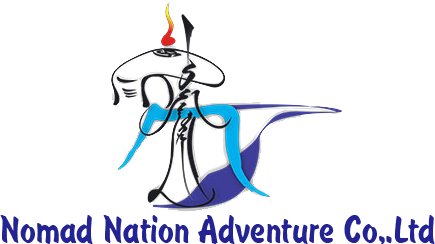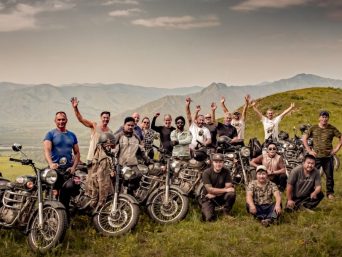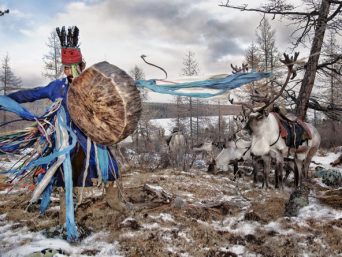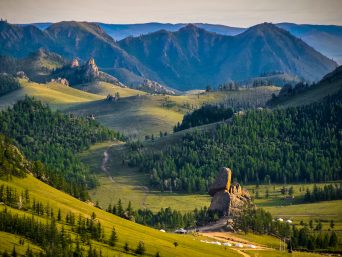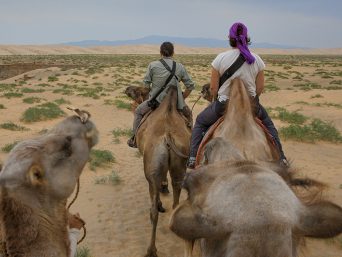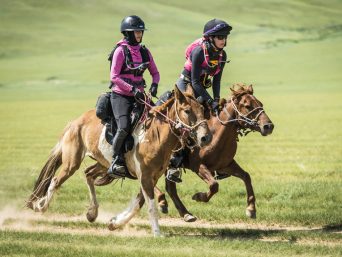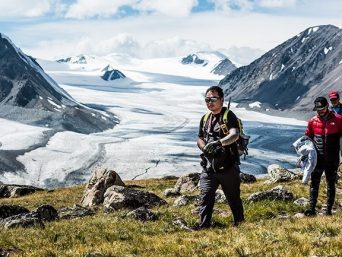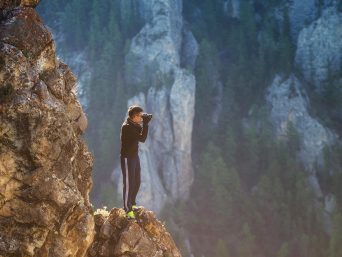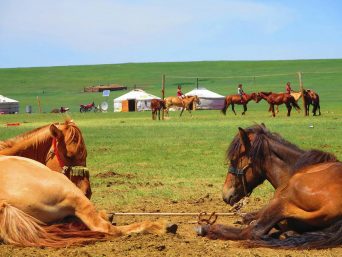Quite possible to modify this program according to your wishes!!!
Day – 1 : Arrive in Ulan Bator city
Arrival at Ulan Bator and transfer to your hotel for a warm shower and a moment to relax after this long flight.
Afternoon, visit of Gandantegchinlin Monastery. Built in 1809, the Gandantegchinlin Monastery – formerly known as the Gandan Monastery – is a Tibetan-style Buddhist monastery located in Ulan Bator. Its name of Tibetan origin can be translated as “Great site full of Joy”.Several hundred monks currently reside there.
It contains a statue of Megjid-Janraiseg (Bodhisattva Avalokiteshvara – called Chenrezig in Tibetan) by 25 meters high.
The original statue, made of copper, was erected in 1911 and was dismantled in 1937 by Soviet troops (the remains of the statue were subsequently used to make bullets during the siege of Leningrad). Following the fall of communist regimes, it was rebuilt in 1996 with donations of gold from Nepal and Japan.
Adorned with gold and nearly 2,286 precious stones, the statue weighs over 20 tons and is covered with nearly 100 kg of silk clothing.
Visit of the National Museum of Mongolian History. The National Museum of Mongolian History tells the story of the country, from prehistoric times to today. In this museum there is also an ethnographic section with costumes and jewels from various ethnic groups of countries: Kazakhstan, Buriats, Clzemchins…
Dinner and overnight at the hotel.
Day – 2 TERELJ National Park to KHUSTAI National Park (90km)
After the breakfast; departure to Khustai National Park.
Declared Biosphere Reserve by UNESCO in 2002, the Hustai National Park covers 50 000 hectares of steppe and mountain forest and is home to many species of mammals and birds.
Lunch at the yurt / ger camp.
It is best known for hosting the conservation project to protect the endangered Takhi. This wild horse, also known as Przewalski’s horse, had completely disappeared from its natural habitat. Only a few specimens were still present in zoos around the world.
A breeding and reintroduction program was initiated in 1992, resulting in a wild and sustainable Takhi population inside the Khustai park which now stands at about 260 individuals.
To observe the Takhi, it is best to travel by vehicle to the banks of rivers where they come to drink early in the morning and evening. The rest of the day, they disperse into the mountains in search for food.
In the afternoon, we go on a drive in the Park to try and find the Takhi.
Dinner and overnight at the yurt camp (2 to 4 persons per yurt, with single beds, showers in a separate building)
Day – 3 KHUSTAI National Park to KHARKHORIN (is the ancient capital of the Mongol Empire)
After breakfast, it is time to say goodbye to our nomad friends, the end of a wonderful human experience, having shared moments of unparalleled freedom.
We must resume our journey to new Mongolian horizons…
We drive towards Kharkhorin (Karakorum) through the Orkhon Valley.
Lunch at the Kharkhorin ger camp.
Visit of Erdene Zuu monastery.
Karakorum (Kharkhoryn) is the ancient capital of the Mongol Empire, founded in 1235 by Ogödei, the son of Genghis Khan.
In 1260, Kublai Khan transfers the capital to Beijing. Karakorum was destroyed in 1388 by troops of the Ming Dynasty. Of its former glory remain mere turtle statues guarding the entrances to the city walls.
In 1585, the Erdene Zuu has been built just outside the walls of the ruins of the ancient capital after the introduction of Buddhism in Mongolia as the state religion. Stones from the ruins of Karakorum were used in the construction.
It is surrounded by a wall with 108 stupas. 108 is a sacred number in Buddhism, and it is also the number of beads in a Buddhist rosary (mala).
The monastery was damaged in the 1680s, but was rebuilt in the eighteenth century and in 1872.
For centuries, Erdene Zuu was the most important religious shrine in Mongolia.
In 1939 the communist leader Horloogiyn Choybalsan destroyed the monastery, in a purge that resulted in the disappearance of hundreds of monasteries in Mongolia and killed over ten thousand monks.
Three small temples and the outer wall with the stupas remained; the temples became museums in 1947.
After the fall of communism in Mongolia in 1990, the monastery was given to lamas and Erdene Zuu again became a place of worship.
The site was restored at the end of the century and regained part of its religious aspect. Today Erdene Zuu remains an active Buddhist monastery as well as a museum that is open to tourists.
Dinner and night at Kharkhorin yurt (ger) camp (2-4 persons per yurt in single beds, shower and toilet in a separate building).
Day – 4 KHARKHORIN to TUVKHEN Monastery

Breakfast and departure for the Orkhon Valley.
We are progressing slowly on tracks surrounded by the famous landscape of the Orkhon Valley.
Classified in 2004 as World Heritage by UNESCO as the cradle of nomadic Mongolia, the “cultural landscape of the Orkhon Valley”, about 121 967 hectares, covers an extensive area of pastureland that stretches approximately 80km from long and 15 km wide on both banks of the Orkhon river.
The site also includes Karakorum.
Grasslands are still used today by Mongolian nomadic herders, and many families keep perpetuating the traditional way of life. In the valleys and around the rivers are nestled yurts that house the nomadic families. In the wild, herds of horses, yaks, sheep and goats are moving in these protected areas.
moving in these protected areas.
Picnic lunch en route.
Short hike to visit the Tovkhon monastery .
Tovkhon monastery towers the Orkhon Valley, at an altitude of 2400 m.
It includes several small temples, the oldest of which was built in 1654 for Zanabazar, who was the first spiritual leader of Buddhists in the line of Gelugpas in Mongolia.
Zanabazar brought a new start to the region on issues related to spirituality, including theology, language, art, medicine and astronomy. He composed sacred music, mastered the art of bronze and painting, and invented Soyombo writing in 1686.
You have to hike to access the monastery, about one hour climbing through a beautiful mountain forest. You can visit the temples and caves which are related to beliefs, like that of a spiritual rebirth after a stint in a very narrow pipe carved in the rock.
The view from the top extends over tens of kilometers beyond the mountain ranges surrounding the Orkhon Valley in long undulating waves, sometimes covered with dark forests, sometimes lined with lush green meadows.
Dinner and night at Talbiun yurt (ger) camp (2-4 persons per yurt in single beds, shower and toilet in a separate building).
Day – 5 TUVKHEN Monastery to VALLEY of ORKHON (nomadic family)
Breakfast; The day is devoted to the discovery of the traditional lifestyle of the nomads of Mongolia.
 Each yurt camp is home to a family whose daily lives are punctuated by the care of herds: milking mares, sheep, goats and dris (female yaks), caring for sick or debilitated animals, moving animals to new pastures…
Each yurt camp is home to a family whose daily lives are punctuated by the care of herds: milking mares, sheep, goats and dris (female yaks), caring for sick or debilitated animals, moving animals to new pastures…
Women also take care of children, they cook, prepare different milk products (butter, cheese, fermented mare’s milk, drinking milk …) and maintain the interior of the yurt.
The men look after animals, maintenance of hardware and harness horses. They also cut wood for cooking.
We can participate in these activities, and become acquainted with the various family members.
You’ll find simple tips to facilitate contact with your host family on the site by clicking here.
During the day, we can easily reach the famous Orkhon Falls, hiking or on horseback.

Picnic lunch.
The Orkhon Falls are actually the Ulaan Tsutgalan River Falls. The river falls into a spectacular canyon formed after an earthquake and a volcanic eruption more than 20 000 years ago, forming a cascade of 20 meters high and 10 meters wide.
The site is enchanted by the contrast between the whiteness of the foam and the black rock that forms the canyon walls. Going down along the walls to the foot of the fall, you will discover trees and flowers (wild peonies) that take advantage of the abundance of water to grow.
Dinner with our host family.
This night, we will sleep in a “guest-yurt” close to our nomad family’s yurts.
The comfort is more simple than in the yurt camps as there are no showers, but you will experience the real nomadic way of life…
Day – 6 ORKHON VALLEY to National Park of KHUGNU TARNA 
Breakfast and departure towards Khogno Khan Park, known as the “Mini-Gobi”.
Picnic lunch en route.
Located about 280 km from the capital, Khogno Khan Park will astonish you with its rock formations, cliffs shaped by erosion overlooking vast semi-desert plains irresistibly reminiscent of the citadels sandstone from Wadi Rum in Jordan.
In this spectacular setting, you will discover the Ovgon Khiid Monastery, built during the 17th century.
The park is also home to huge sand dunes offering a variety of stunning landscapes that earned the region its nickname of “Mini Gobi”.
Afternoon visit of the Ovgon Khiid Monastery.
Short hike in the Elsentasarhaï sand dunes.
Optional: Camel ride in this beautiful scenery.
Dinner and overnight at Khogno Khan yurt (ger) camp (2-4 persons per yurt in single beds, shower and toilet in a separate building).
Day – 7 KHUGNU TARNA National Park to Ulan Bator
Breakfast and drive to Ulan Bator.
Picnic lunch.
Afternoon is dedicated to shopping in stores downtown, or at the Narantuul “black market” where you will find traditional clothing and objects of daily life.
Visit a cashmere factory.
In the late afternoon, you will attend a show with traditional dances, music and songs from Mongolia, especially the amazing Khoomei.
The Khoomei is an overtone singing (throat singing) in which the singer produces two distinctively audible pitches at the same time, including a low pedal note, or drone, derived from the fundamental frequency of the vocal cord vibrations, and higher melodic notes that result when the singer’s mouth acts as a filter, selecting one note at a time from among the drone’s natural overtone series pitches.
The sound is reminiscent of the Jew’s harp.
This type of song is recorded in Intangible Cultural Heritage of Humanity by UNESCO in 2010.
Dinner downtown and overnight at a 2* hotel (local standard) in the center of Ulan Bator.
Day – 8 Return Home
Breakfast (depending on your flight schedule) and transfer to airport for your flight back home
